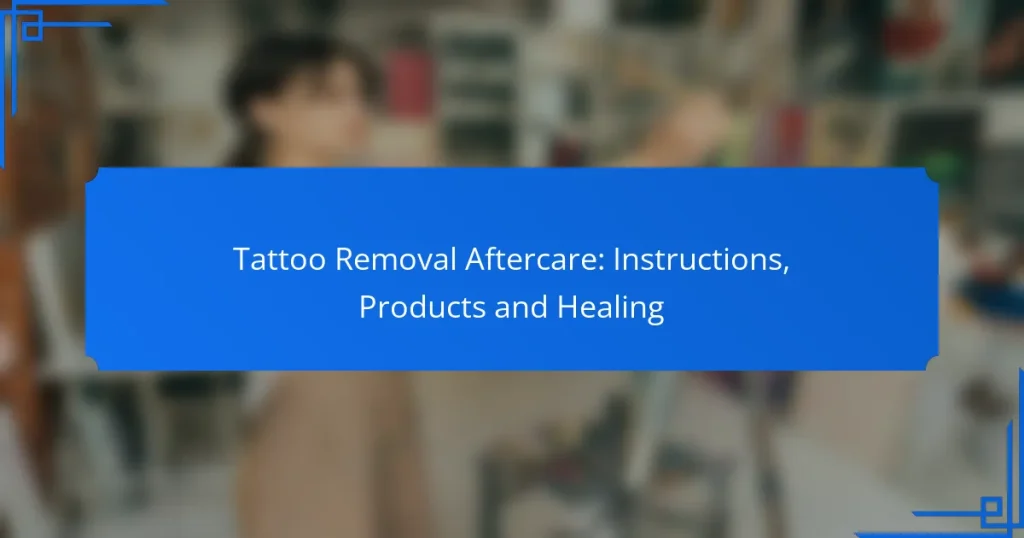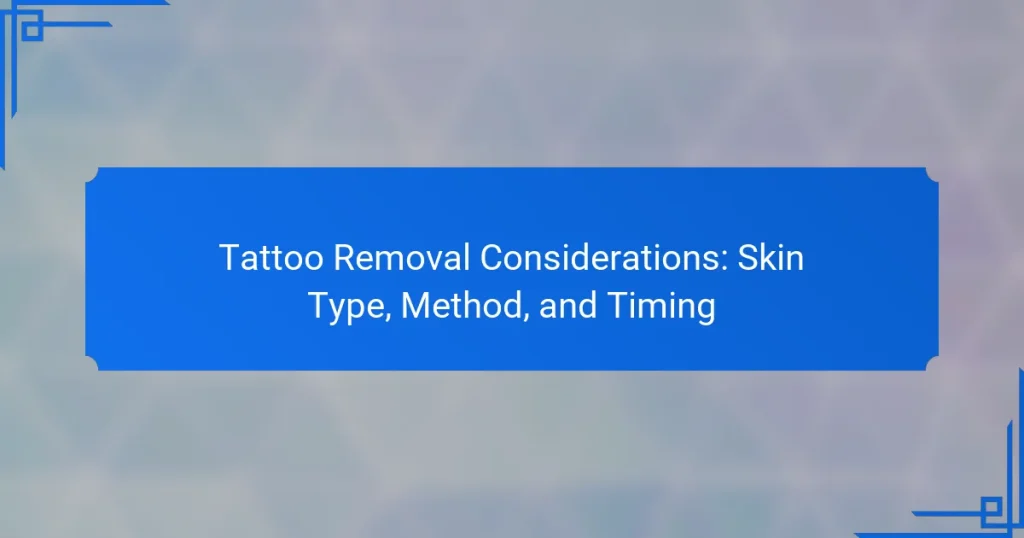Tattoo removal has become increasingly popular, with several methods available to help individuals erase unwanted ink. Options such as laser removal, dermabrasion, chemical peels, saline removal, and excision each offer unique benefits and drawbacks. Understanding the effectiveness, recovery time, and costs associated with each method is crucial for making an informed decision tailored to personal circumstances.
Tattoo Removal Options: Budget, Safety and Results
Tattoo Removal Misconceptions: Pain, Effectiveness and Safety
Tattoo Removal Methods: Techniques, Costs, Effectiveness
Tattoo Removal Process: Steps, Duration and Expectations
Tattoo Removal Considerations: Skin Type, Method, and Timing
Tattoo Removal Professionals: Qualifications, Experience and Reviews
What Are the Main Tattoo Removal Options?
The main tattoo removal options include laser tattoo removal, dermabrasion, chemical peels, saline tattoo removal, and excision. Each method varies in effectiveness, recovery time, and cost, making it essential to choose the right option based on individual needs and circumstances.
Laser Tattoo Removal
Laser tattoo removal is the most common and effective method for eliminating tattoos. It works by using concentrated light beams to break down the ink particles in the skin, which are then absorbed by the body. Multiple sessions are typically required, and the process can take several weeks to months, depending on the tattoo’s size and color.
Considerations include potential discomfort during the procedure and the possibility of skin discoloration. It’s advisable to consult with a certified professional to discuss expected results and any risks involved.
Dermabrasion
Dermabrasion involves mechanically sanding the skin to remove the outer layers where the tattoo ink resides. This method can be effective but may result in significant discomfort and a longer recovery time compared to laser treatments. Patients may experience swelling and redness post-procedure.
It’s crucial to have this procedure performed by a qualified dermatologist to minimize risks and ensure proper healing. Results can vary, and multiple sessions may be necessary for complete removal.
Chemical Peels
Chemical peels use acidic solutions to exfoliate the skin and fade tattoos over time. This method can be less invasive than dermabrasion but may require several applications to achieve desired results. The depth of the peel will determine its effectiveness and potential side effects.
Patients should be aware of possible skin irritation and the need for aftercare to protect the treated area. Consulting with a skincare professional can help determine the best type of peel for specific tattoo characteristics.
Saline Tattoo Removal
Saline tattoo removal involves injecting a saline solution into the skin, which draws out the ink. This method is often considered safer for those with sensitive skin and can be effective for certain types of tattoos. However, it may require multiple sessions and can lead to scabbing during the healing process.
It’s important to choose a skilled practitioner familiar with this technique to ensure the best outcomes. Aftercare is essential to prevent infection and promote healing.
Excision
Excision is a surgical method where the tattooed skin is cut out and the surrounding skin is stitched together. This option is typically used for smaller tattoos and can provide immediate results. However, it leaves a scar, which may be a significant consideration for many individuals.
Excision is often performed under local anesthesia, and recovery can take a few weeks. It’s vital to discuss the potential for scarring and the overall aesthetic outcome with a qualified surgeon before proceeding.
How Effective Are These Methods?
The effectiveness of tattoo removal methods varies significantly based on factors like the tattoo’s age, ink type, and skin type. Generally, laser removal is considered the most effective, while dermabrasion and chemical peels may yield mixed results.
Laser Removal Success Rates
Laser removal is widely regarded as the gold standard for tattoo removal, with success rates ranging from 70% to 90% depending on the tattoo’s characteristics. The procedure works by using concentrated light beams to break down ink particles, which are then absorbed by the body. Multiple sessions are usually required for optimal results.
Factors such as ink color, depth, and skin type can influence the effectiveness of laser treatments. Darker inks typically respond better than lighter colors, and older tattoos often fade more easily than newer ones.
Dermabrasion Effectiveness
Dermabrasion involves mechanically exfoliating the skin to remove the tattoo. This method can be effective for some, but results vary widely, with success rates generally lower than those of laser removal. It may require several sessions and can lead to scarring or changes in skin texture.
Patients should consider their skin type and the tattoo’s location before opting for dermabrasion. It’s crucial to consult with a qualified professional to assess potential risks and benefits.
Chemical Peel Results
Chemical peels use acidic solutions to remove the outer layers of skin, which can help fade tattoos. However, their effectiveness is often limited, and results can be inconsistent. Success rates are generally lower than laser removal, and multiple treatments may be necessary.
Choosing the right type of chemical peel is essential, as stronger peels can cause more significant skin irritation and longer recovery times. Consulting a dermatologist can help determine if this method is suitable for your specific tattoo and skin type.
What Are the Costs of Tattoo Removal?
The costs of tattoo removal can vary significantly based on the method used, the size and complexity of the tattoo, and the geographic location of the service provider. Generally, individuals can expect to pay anywhere from a few hundred to several thousand dollars for complete removal.
Average Laser Removal Costs
Laser tattoo removal is one of the most common methods and typically ranges from $200 to $500 per session. The total number of sessions required can vary, often ranging from 5 to 15, depending on the tattoo’s size, color, and depth.
Factors influencing the cost include the type of laser used and the expertise of the technician. It’s advisable to consult with a certified professional to get an accurate estimate based on your specific tattoo.
Dermabrasion Pricing
Dermabrasion, which involves physically sanding the skin to remove the tattoo, usually costs between $1,000 and $3,000 for a single session. This method may require multiple treatments and can lead to longer recovery times compared to laser removal.
Patients should consider the potential for scarring and the need for aftercare, which can add to overall expenses. It’s important to discuss these factors with a qualified dermatologist before proceeding.
Saline Removal Expenses
Saline tattoo removal is a less common method that typically costs between $150 and $300 per session. This technique involves injecting a saline solution into the skin to draw out the ink and may require several sessions for complete removal.
While saline removal can be effective for certain tattoos, it may not work as well on all ink colors. Consulting with a professional can help determine if this method is suitable for your specific tattoo.
What Are the Risks and Side Effects?
Tattoo removal can involve various risks and side effects that vary by method. Understanding these potential issues is crucial for making an informed decision about the best removal option for your needs.
Laser Removal Risks
Laser tattoo removal is generally safe but can lead to risks such as skin irritation, scarring, and changes in skin pigmentation. The intensity of these side effects often depends on skin type, tattoo ink colors, and the laser technology used.
Patients may experience temporary redness and swelling after treatment, which typically resolves within a few days. It’s essential to follow post-treatment care instructions to minimize these risks.
Dermabrasion Side Effects
Dermabrasion involves physically sanding the skin to remove the tattoo, which can result in side effects like bleeding, swelling, and infection. The recovery period can be longer compared to laser removal, often requiring several weeks for the skin to heal.
Additionally, there is a risk of scarring and changes in skin texture, especially if the procedure is not performed by a qualified professional. Proper aftercare is vital to ensure optimal healing and results.
Potential Complications
Complications from tattoo removal can include allergic reactions to topical anesthetics or other substances used during the procedure. Some individuals may also experience prolonged pain or discomfort in the treated area.
In rare cases, tattoos may not be completely removed, leading to dissatisfaction with the results. Consulting with a qualified practitioner and discussing potential complications beforehand can help mitigate these risks.
How to Choose the Right Method?
Choosing the right tattoo removal method depends on factors like the tattoo’s size, color, location, and your skin type. Evaluating these elements will help you select a technique that balances effectiveness with safety and comfort.
Factors to Consider
When selecting a tattoo removal method, consider the tattoo’s age, ink type, and depth. Older tattoos may fade more easily, while vibrant colors like green and blue can be more challenging to remove. Additionally, the location on your body can affect healing and pain levels.
Skin type is another crucial factor. Individuals with darker skin may experience more complications, such as hyperpigmentation, with certain removal methods. Consulting with a professional can help determine the best approach for your specific skin type.
Consultation Importance
<pA thorough consultation with a qualified specialist is essential before proceeding with any tattoo removal method. This meeting allows for a personalized assessment of your tattoo and skin, ensuring that the chosen technique aligns with your needs and expectations.
During the consultation, discuss your medical history, skin sensitivities, and any concerns you may have. A professional will also explain the potential risks and side effects associated with different methods, helping you make an informed decision.
What Are the Aftercare Requirements?
Aftercare is crucial for effective tattoo removal, as it helps minimize complications and promotes healing. Proper aftercare can significantly influence the success of the procedure and reduce the risk of infection or scarring.
Post-Laser Care
After laser tattoo removal, it is essential to keep the treated area clean and dry. Avoid soaking the area in water for at least a week, which includes swimming pools, hot tubs, and baths. Instead, gently wash the area with mild soap and water.
Applying a thin layer of antibiotic ointment can help prevent infection. It’s also important to avoid sun exposure; use a broad-spectrum sunscreen with a high SPF if you must go outside. This protects the healing skin and prevents pigmentation changes.
After Dermabrasion Care
Following dermabrasion, the skin will be sensitive and may scab over. Keep the area moisturized with a recommended ointment and avoid picking at scabs, as this can lead to scarring. It’s advisable to wear loose clothing to prevent irritation.
Similar to laser care, sun protection is vital. Use sunscreen to shield the treated area from UV rays, and avoid direct sunlight for several weeks. Monitor for any signs of infection, such as increased redness or pus, and consult a healthcare professional if these occur.






